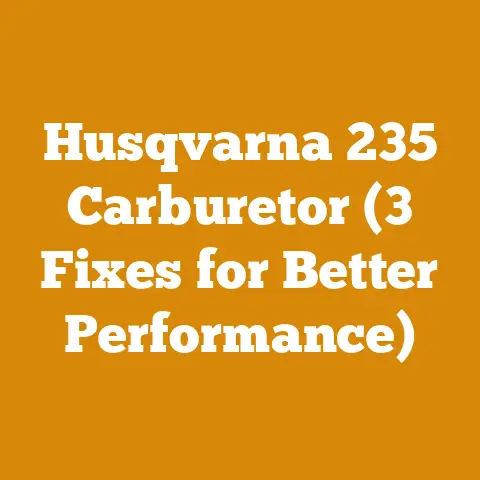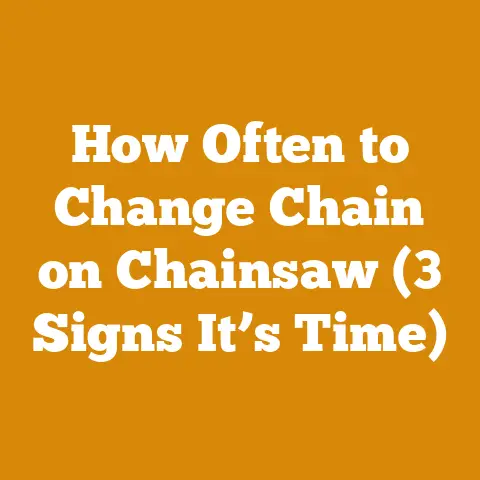Echo vs Stihl Leaf Blower (4 Key Differences)
Ever find yourself raking leaves on a crisp autumn day, reminiscing about the good ol’ days?
I sure do.
There’s something about leaf blowers—Echo and Stihl, in particular—that brings me back to those weekends spent cleaning up the yard.
Let’s explore the fascinating world of these two popular brands and dive into the key differences between Echo and Stihl leaf blowers, sharing personal experiences, tips, and insights along the way.
Echo vs. Stihl Leaf Blowers: An Overview
Both Echo and Stihl are renowned in the world of outdoor power equipment.
They offer a range of leaf blowers, but how do you choose between them?
I’ve had my fair share of experiences with both, and I’m here to share insights that might help you decide.
1. Performance and Engine Power
Echo and Stihl leaf blowers vary significantly in performance, primarily due to their engine power.
Echo Leaf Blowers
Echo has a reputation for producing blowers with impressive engine power.
These machines often boast higher CFM (Cubic Feet per Minute) ratings, translating to greater leaf-clearing capabilities.
Personally, I’ve found Echo blowers to be particularly effective for larger yards.
There was a time when I took on the daunting task of clearing a neighbor’s sprawling yard after a storm.
The Echo blower I used made light work of the thick carpet of leaves and debris that had piled up.
A key feature of Echo blowers is their ability to maintain consistent power output even under heavy loads.
This is especially crucial when dealing with wet leaves or stubborn debris.
I recall an instance during a particularly rainy autumn when my trusty Echo blower powered through soggy piles with ease.
The robust engine didn’t falter, showcasing Echo’s commitment to performance.
Stihl Leaf Blowers
Stihl blowers, while competitive in power, often focus on achieving a balance between performance and fuel efficiency.
I remember using a Stihl blower during a particularly windy fall season and appreciating its smooth operation and fuel-saving features.
The blower’s ability to adjust airspeed allowed me to tailor its performance to different tasks, whether I was dealing with light leaf litter or heavier debris.
Stihl’s innovative engine technology contributes to its superior fuel efficiency.
I was once involved in a community cleanup project where we used Stihl blowers for several hours straight.
The fuel economy was remarkable, allowing us to work longer without frequent refueling breaks.
2. Design and Ergonomics
The design and ergonomics of a leaf blower can make a big difference, especially if you’re planning on using it for extended periods.
Echo Design
Echo tends to prioritize lightweight designs without sacrificing power.
I’ve spent long hours with an Echo strapped to my back, and the reduced strain on my shoulders was noticeable.
The ergonomic design includes padded harnesses that distribute weight evenly, minimizing fatigue during prolonged use.
One memorable experience involved clearing leaves from a large park area.
The Echo blower’s lightweight construction allowed me to maneuver effortlessly around trees and obstacles, covering more ground efficiently.
The comfortable handle grip also provided excellent control, ensuring precision even in tight spaces.
Stihl Design
Stihl often emphasizes user comfort with padded harnesses and adjustable handles.
If comfort is a top priority for you, Stihl might have an edge here.
I recall a friend who swears by his Stihl blower because of its ergonomic design.
He once mentioned how the adjustable harness allowed him to customize the fit for maximum comfort during extended sessions.
Stihl’s attention to detail extends to vibration reduction technology, which minimizes user fatigue caused by prolonged exposure to vibrations.
This thoughtful design element enhances the overall user experience, making Stihl blowers a popular choice among professionals who rely on their equipment day in and day out.
3. Noise Levels
Noise levels can be a deal-breaker for some, especially if you live in a neighborhood with strict noise regulations.
Echo Noise Levels
Echo blowers can be somewhat louder, which is something to consider if you’re concerned about disturbing the peace.
I’ve had neighbors give me the side-eye more than once while using an Echo blower early on a Saturday morning.
However, it’s worth noting that Echo has made strides in noise reduction technology in recent years.
During a community event focused on environmental awareness, I demonstrated an Echo blower equipped with noise-reducing features.
The participants were pleasantly surprised by how much quieter it was compared to older models.
This advancement not only benefits users but also helps maintain harmony in residential areas.
Stihl Noise Levels
Stihl tends to produce quieter models, focusing on noise reduction features.
It’s something I appreciate when working around sensitive areas or during early hours.
One early morning, I was tasked with clearing leaves from a school playground before classes began.
The Stihl blower’s quiet operation ensured minimal disruption to nearby classrooms.
Stihl achieves reduced noise levels through advanced muffler systems and engine designs that prioritize quieter combustion processes.
This makes them an excellent choice for users who value peace and quiet without compromising on performance.
4. Price and Value for Money
Finally, let’s talk about budget—a crucial factor in any purchasing decision.
Echo Pricing
Echo blowers are generally more affordable, offering great value for money, especially if you need a powerful tool without breaking the bank.
My first Echo blower was a budget-friendly option that didn’t compromise on quality.
It served me well for several years before I decided to upgrade to a more advanced model.
The affordability of Echo blowers doesn’t mean sacrificing features or durability.
In fact, many homeowners find that Echo delivers exceptional performance at a price point that’s accessible for most budgets.
This makes them an attractive option for both new users and seasoned professionals looking for reliable equipment.
Stihl Pricing
Stihl products often come with a higher price tag but offer advanced features and durability.
It’s an investment that many seasoned users are willing to make for long-term reliability.
A colleague once shared his experience of purchasing a high-end Stihl blower for his landscaping business.
Despite the initial cost, he found that the blower’s longevity and performance justified the investment over time.
Stihl’s commitment to quality craftsmanship is evident in every product they offer.
The materials used in construction are designed to withstand heavy use and challenging environments, ensuring that your investment pays off over the years.
Prerequisites and Required Materials
Before diving into your new leaf blower purchase, consider these prerequisites:
- Knowledge of Basic Operation: Familiarize yourself with leaf blower basics.
- Safety Gear: Eye protection and earplugs are essential.
- Area Assessment: Know the size and type of area you’ll be maintaining.
Understanding these prerequisites will ensure you’re well-prepared to handle your leaf blower effectively and safely.
Safety Tips for Using Leaf Blowers
- Wear protective eyewear to prevent debris from hitting your eyes.
- Use ear protection to mitigate noise exposure.
- Keep loose clothing away from the blower’s intake.
- Operate in daylight and clear visibility conditions.
Warning: Avoid using the blower near open flames or flammable materials.
Safety should always be a top priority when operating any power equipment.
By following these tips, you can reduce the risk of accidents and ensure a safe working environment.
Troubleshooting Common Issues
Problem: Blower Won’t Start
- Check Fuel Level: Ensure there’s enough fuel and that it’s fresh.
- Inspect Spark Plug: Clean or replace if necessary.
- Fuel Line Check: Ensure there are no blockages or leaks.
Troubleshooting these common issues can help you get your blower up and running quickly without unnecessary frustration.
Problem: Decreased Airflow
- Check Filters: Clean or replace dirty air filters.
- Inspect Tubes: Remove any debris blocking the tubes.
Regular maintenance and inspection can prevent these issues from occurring in the first place, ensuring consistent performance throughout the season.
Best Practices for Maintenance
- Regularly clean air filters.
- Check spark plugs frequently.
- Store the blower in a dry place to prevent rust.
By following these best practices, you can extend the lifespan of your leaf blower and maintain its performance over time.
Important Reminders
- Always read the user manual thoroughly.
- Perform routine maintenance checks.
- Consider environmental factors like noise restrictions before use.
These reminders serve as essential guidelines for responsible ownership and operation of your leaf blower.
Next Steps
Now that you know more about Echo and Stihl leaf blowers, think about what features matter most to you.
Is it power, comfort, or perhaps budget?
Armed with this knowledge, you’re ready to make an informed decision.
Consider visiting local dealers or authorized retailers to test out different models and get a feel for their performance firsthand.
This hands-on experience can help you determine which brand aligns best with your needs and preferences.
FAQ Section
Q: Which brand is more reliable?
A: Both brands are reputable; it depends on your specific needs for power and comfort.
Consider factors like intended use, frequency of operation, and personal preferences when deciding which brand suits you best.
Q: Can I use these blowers for wet leaves?
A: Yes, but be cautious as wet leaves can be heavier and require more power.
It’s important to choose a model with sufficient airflow capacity (CFM) to handle wet debris effectively.
Q: How often should I service my blower?
A: Regularly check your blower every few months or after heavy use.
Routine maintenance ensures optimal performance and prevents unexpected breakdowns during peak usage periods.
Q: Are there electric models available?
A: Yes, both Echo and Stihl offer electric options suitable for quieter operation.
Electric models are ideal for smaller properties or areas where noise restrictions apply.






